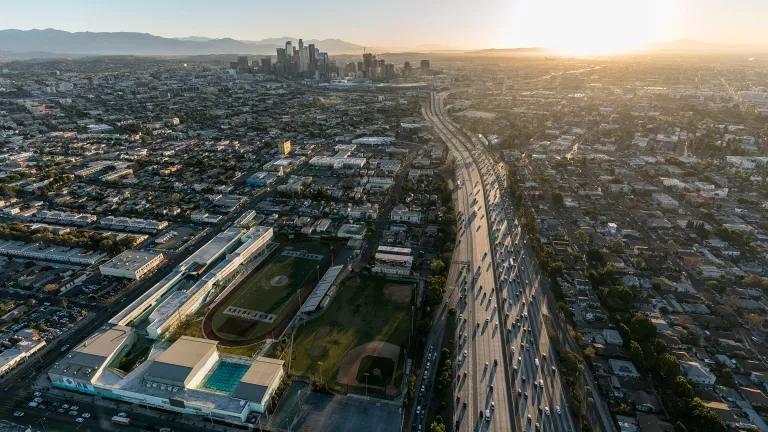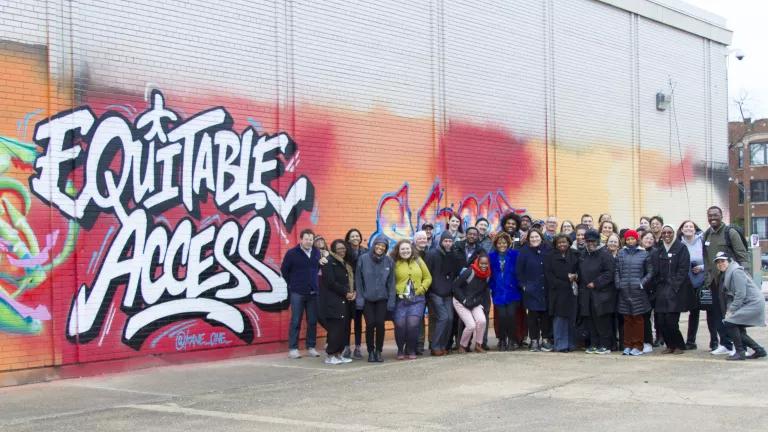
Flooding may be worse than it appears. FEMA only maps the 100-year floodplain with a 50th percentile confidence, so there is only a 50 percent chance that a 100-year flood will fall inside the line that FEMA draws on its maps.
If the nation is going to successfully adapt to sea level rise and flooding that is more frequent and severe due to climate change, we need more reliable flood maps that show where flooding is likely to occur both now and in the future. And we need to put a halt to some of the worst practices when it comes to floodplain development.
FEMA received three recommendations from an advisory panel that—if implemented—would greatly improve the reliability of its flood maps and put an end to the practice of fill and build, which often increases flood risks in a community.
Those recommendations include:
- Mapping flood risk with much higher certainty for purposes of determining where people are required to purchase flood insurance. Doing so would give a larger number of people a more accurate picture of their vulnerability to flood disasters and make them aware of the importance of having flood insurance coverage for their home.
- Mapping the floodplain of the future, instead of the floodplain of the past. Mapping the future floodplain would require an assessment of projected development as well as climate impacts like sea level rise and extreme storms. This would drive better decisions about where it’s safe to build for the long-term.
- Banning the practice of fill and build, whereby fill (i.e. dirt) is piled up and homes built on top. Sometimes, entire subdivisions are done using fill and build. A prohibition would finally put an end to a practice that provides some protection to homes built on fill, while increasing runoff and flood risk to all surrounding properties. Oftentimes, those surrounding properties belong to disadvantaged communities who live in low-lying areas due to the legacy of redlining and discriminatory housing practices that put them there.
American Rivers, Anthropocene Alliance, National Wildlife Federation, NRDC, The Nature Conservancy, Southern Environmental Law Center, and the Union of Concerned Scientists recently sent a letter to FEMA Administrator Deanne Criswell urging them to implement these recommendations.
Mapping flood risk with a much higher confidence for purposes of determining where people are required to purchase flood insurance
Presently, the flood maps produced by FEMA under-represent the true extent of the 100-year floodplain and, therefore, under-represent the actual risks of flooding. One reason that flooding seems to occur well outside the mapped floodplain is because FEMA only maps the 100-year floodplain with a 50th percentile confidence.
That means there is only a 50 percent chance that a 100-year flood would stay inside the line that FEMA draws on its maps. In other words, we are making development decisions with the certainty of a coin flip. Heads, your house goes under water. Tails, you stay dry. We deserve better odds.
“We are making development decisions with the certainty of a coin flip. Heads, your house goes under water. Tails, you stay dry. We deserve better odds.”
Nowhere else do we site, design, and engineer major infrastructure projects, not to mention homes and businesses, with only a 50th percentile certainty. Imagine if we engineered bridges and skyscrapers with the confidence of a coin toss? We’d probably see a whole lot of bridges and buildings collapse.
But we have been flipping the proverbial coin on floodplain development since the the National Flood Insurance Program started producing flood maps.
The results have not been good.
According to FEMA, NFIP policy holders who live outside the mapped floodplain, “file more than 25 percent of NFIP claims and receive one-third of disaster assistance for flooding.” Even worse, almost 20 percent of the most flood-prone properties in the country (what FEMA calls Severe Repetitive Loss Properties, which have each flooded five times on average) also are located outside the floodplain, as currently delineated.
That’s a lot of coin flips that turned out quite badly for the owners of those properties.
When so much flood damage happens in areas identified as low-risk on flood maps, the maps clearly have some problems. Mapping flood risk with a higher degree of certainty will show a truer picture of the areas that are vulnerable to flooding.
Mapping the floodplain of the future, instead of the floodplain of the past
For far too long, FEMA’s flood maps have defined flood risk based solely on past events. Historical storms are used to calibrate computer models that are used to map flood risk, on the assumption that the past should inform future decisions.
But what happens if the past doesn’t look like the future, which is definitely the case due to climate change? Sea levels are rising. Flood disasters are more frequent and severe because of climate change. That is now the world we live in. Basing decisions on past conditions makes absolutely no sense.
By not taking climate impacts and other factors into account, communities are using bad flood maps to make even worse decisions about where it’s safe to build.
FEMA is now looking at how flood maps can incorporate information on future climate impacts. This would ensure that flood maps capture areas that are at risk today, as well as areas that will be at risk decades from now.
“By not taking climate impacts and other factors into account, communities are using bad flood maps to make even worse decisions about where it’s safe to build.”
That’s important, because decades from now we will still be relying on the homes, businesses, and infrastructure we build today. Making sure flood maps accurately portray those future risks is critical to making informed decisions.
The advisory panel also recommended that FEMA begin accounting for future development in its flood maps. When new areas are developed, it can radically change the amount of runoff and the extent of flooding, especially in sprawling urbanizing areas. Finally, it was recommended that FEMA map this future floodplain with the same 95th percentile confidence that was recommended above.
The areas that fall within this future floodplain will define where federal floodplain development standards will be in effect. All building and land use codes in the United States must be at least as protective as FEMA’s federal floodplain development standards. Inside the line of the 100-year floodplain, FEMA’s minimum standards apply. But outside that line, state and local governments are free to apply weaker siting and construction standards, if they choose, and many do.
When standards are weak, or don’t apply to areas inaccurately mapped as low-risk, then communities allow unsafe development in the wrong places.
By capturing future impacts of climate change and development, the nation’s flood maps will give a more accurate picture of current and future flood risks. By doing so, it will also ensure that the minimum federal floodplain development standards apply to a much larger area than before.
If implemented, the result will be buildings and infrastructure that are sited and designed with the future in mind. That’s the kind of long-term thinking we need if we’re going to adapt to the impacts of climate change.
Banning the practice of fill and build
The final recommendation groups urged FEMA to implement was prohibiting fill and build for residential and commercial structures.
Developers commonly place earthen fill (i.e. dirt) to elevate a plot of land out of the floodplain—a practice often referred to as fill and build. This practice is bad enough when applied to individual parcels of land and can create even bigger issues when it is allowed for entire new developments and subdivisions. There are many negative consequences of fill and build, as was pointed out by FEMA’s own advisory panel:
- Reduces the carrying capacity of the floodplain, increasing flood risk over time;
- Allows construction of homes that are just barely over the base flood elevation, leaving no margin of error;
- Once homes are constructed on fill, they are no longer legally required to purchase flood insurance, even though the flood risk is only marginally less than surrounding areas;
- Homes constructed on fill often are allowed to build basements, which are much more likely to flood and pose a safety risk to those who live in below grade units or rooms; and
- Severely impacts floodplain ecosystems that are critical habitat for endangered species.
FEMA should ban fill and build. For too long, developers have been able to place homes in harm’s way by building on a pile of dirt. The result has been more people living in risky areas and a gradual increase in the potential for flooding in surrounding areas. When a storm comes, the water has to go somewhere. And if you live down gradient from the fill and build development, that water’s coming to your house.
Fill and build transfers someone else’s flood risk onto you. That’s not fair and it’s disastrous public policy.
Hopefully, FEMA acts on this recommendation and bans fill and build once and for all.
Final thoughts
As the agency that administers the National Flood Insurance Program, FEMA has a legal responsibility to provide accurate maps of flood risk and establish federal floodplain development standards. Those maps define where the standards apply and they serve as the floor for building codes and land use ordinances in all 50 states, 7 U.S. territories, and over 22,000 local government jurisdictions.
In 2021 NRDC and the Association of State Floodplain Managers filed a petition for rulemaking, laying out how FEMA had failed to perform its duties and that it needed to account for future climate impacts in flood maps and update decades out-of-date floodplain development standards.
FEMA granted that petition and is now working to overhaul many aspects of the regulations that govern floodplain development. Last April, FEMA asked an expert panel of advisors for its recommendations and that panel finalized its recommendations recently. Now we will see how FEMA integrates these into draft regulations that should be released in the coming months.
If the nation is going to stay ahead of the curve and adapt to rising sea levels and the growing likelihood of flood disasters, then we need to raise the bar on development standards. And we need to give people and communities much more credible and trustworthy information about flood risks. Putting these recommendations into FEMA’s regulations is essential to achieving those outcomes.



